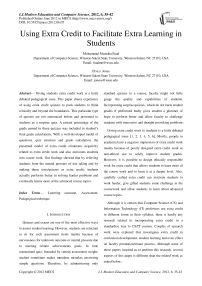Using Extra Credit to Facilitate Extra Learning in Students
Автор: Mohammad Muztaba Fuad, Elva J. Jones
Журнал: International Journal of Modern Education and Computer Science (IJMECS) @ijmecs
Статья в выпуске: 6 vol.4, 2012 года.
Бесплатный доступ
Giving students extra credit work is a hotly debated pedagogical issue. This paper shares experience of using extra credit quizzes to push students to think critically and beyond the boundaries. This particular type of quizzes are not announced before and presented to students as a surprise quiz. A certain percentage of the grade earned in these quizzes was included in student's final grade calculations. With a well-developed model of questions, quiz structure and grade calculation, the presented model of extra credit eliminates negativity related to extra credit work and also motivates students into course work. Our findings showed that by relieving students from the mental pressure of testtaking andby making those tests/quizzes as extra credit; students actually performs better in solving harder problems and eventually learns more of the advanced course topics.
Learning outcome, Assessment, Pedagogical technique
Короткий адрес: https://sciup.org/15011429
IDR: 15011429
Текст научной статьи Using Extra Credit to Facilitate Extra Learning in Students
Published Online June 2012 in MECS DOI: 10.5815/ijmecs.2012.06.05
Quizzes and exams are one of the most effective ways to assess student learning. However, students are reluctant to sit for such assessment items mainly because of nervousness for unknown outcome or mental pressure due to meeting certain achievements goals. In time constrained quiz, bounded by certain assessment weight; student sometimes makes mundane mistakes answering simple questions. Therefore, by administering only standard quizzes in a course, faculty might not fully gauge the quality and capabilities of students. Incorporating surprise quizzes, which do not harm student grades if performed badly gives student a glimmer of hope to perform better and allow faculty to challenge students with innovative and thought provoking problems.
Giving extra credit work to students is a hotly debated pedagogical issue [1, 2, 3, 4, 5, 6]. Mostly, people in academia have a negative impression of extra credit work mainly because of poorly designed extra credit work or non-ethical use to solely improve student grades. However, it is possible to design ethically responsible work for extra credit that allows students to learn more of the course work and to learn it at a deeper level. Also, carefully crafted extra credit can motivate students to work harder, give gifted students some challenge in the coursework and allow students to learn about advanced course topics.
Although it is certain that Computer Science (CS) and Information Technology (IT) professors use extra credit in different forms in their syllabus, there is hardly any research related to incorporating extra credit in a standardize way to CS/IT courses. Couples of research work were explored that investigates extra credit in curriculum development, student learning and even effect on faculty promotion/tenure process. Although some of those papers inspired us to perform this research, several aspects of this paper is different than the related work as stated below:
This paper presents a rigid methodology to use extra credit to motivate students to perform better in advanced topic and learn more out of a Computer Science course. By following similar methodology, other courses in sciences and engineering can also be enriched and student learning can be extended.
The rest of the paper is organized as follows: Section II provides necessary background information to comprehend the findings of the paper. Section III presents the findings and discusses on different aspects of the findings. Finally, Section IV concludes the paper.
-
II. Backdrop
This section discusses about the overall approach and related information needed to comprehend the findings of this paper.
-
A. The Course
The course used for this research is a sophomore level course required for both Computer Science and Information Technology majors. This course covers the organization and functional design of computer components by exposing students to fundamentals of digital logic and involving them to circuit design, analysis and implementation. This course was taught by the authors (first author as the assigned instructor and the second author as the supervising role) from Fall of 2007 till Spring of 2011 (excluding Spring of 2010); a total of
seven times. The pre-requisite for the course is basic knowledge of computing and programming and most students finished the pre-requisites before joining this class and a few re-took the pre-requisite course alongside this course (may be because last time they failed). The method of instruction for this course consists of lectures and in-class laboratory sessions. The classes were 75 minutes long and meet twice per week. The course has a diverse range of assessment items to evaluate studentlearning outcomes. Assessment items included writing assignments, quizzes, labs, and project, mid-term and final exam. These assessment items were pre-scheduled and exact dates for those items were mentioned in the course syllabus and announced in the class at the beginning of the semester. The final grade for this course was calculated as a weighted average of points attained in those assessment items. The same textbook was used for every semester.
-
B. The Student Body
Although this course is a sophomore level course, it generally had a combination of traditional, non-traditional and transfer students. Fig.1 shows general statistics about the student body. Because of the non-traditional students in the class, the average age of the students was sometimes bit higher than usual. The ratio of male to female students followed general trends.
Fig. 2 shows the average credit hours students were enrolled in each semester. The average resembles a typical sophomore student’s course load in the department, where they are advised to take an average of 16-17 credit hours in sophomore semesters. It is evident that, students are not overly busy with other coursework and that they should be able to concentrate equally to their coursework.We also looked at how much student is busy outside the class. Fig. 3 shows the average number of hours students were employed per week and how much time they studied for this course per week. Although the students are working part time, they are small enough to impact their course work. Students are also spending time after the class to go over the course material, which is not enough that one can hope; however gives us some insight that students are involved in the course work even after leaving the class.
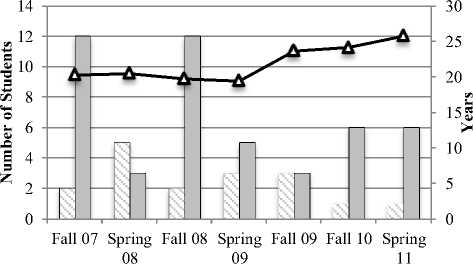
Female Male Average Age
90% students taking this survey and giving us feedback. Therefore we can safely assume that the data represented in these graphs represents general class characteristics. For Fig. 2 and Fig. 3, we eliminated the first two semesters, only because couple of the questions was different or not present in the survey of those semesters.
-
C. Quiz Type
Figure 1. Information on Student Body.
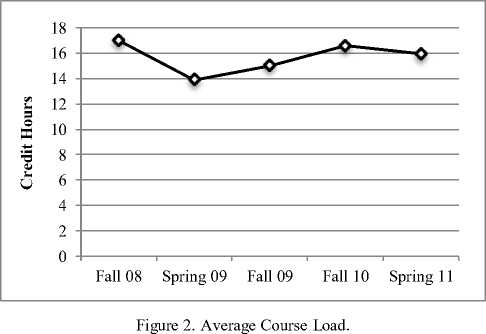
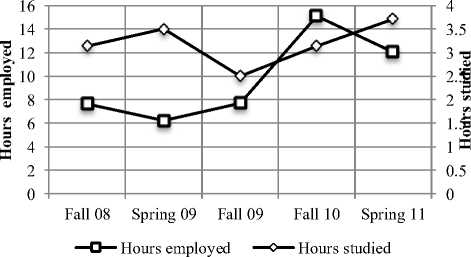
Figure 3. Average Load Outside Class.
There were two kinds of quizzes used in this course. One was scheduled quiz that had a pre-announced date and content. The other was extra credit quiz, which was administered as surprise quiz and given without any prior announcements. This way we were able to gauge how students are coping with lectures, whether they are studying or not and whether they understand content covered in class. Since these are treated as extra credit, students are not in ‘exam anxiety’ and if they attend regularly, the problems in the extra credit quizzes should not seem alien to the students. This motivates students to attend class regularly. Since students know that the questions in the extra credit quizzes would be higher in difficulty level than the problems in the scheduled quizzes, they push themselves to use their analytical skills to solve those harder problems. We followed closed book/note exam policy for every quiz and exam in the course, whether it is scheduled or surprise. Usually most of these surprise quizzes had at least two questions with equal weights. However, sometimes there might be one question with multiple sub-parts that students have to solve. In every case, efforts have been made to have thesame point value for every surprise quiz given. On average, 6-8 surprise quizzes were administered every semester placed equally between scheduled exams and quizzes. Table 1 summarizes characteristics of both quiz types.
The data presented in the above graphs are collected from the student rating of classroom instruction survey, given to the students at the end of every semester. Taking the survey is optional for students and is administered without any influence. On average, we received around table 1. Comparison of quiz type
|
Aspect |
Scheduled Quiz |
Extra-Credit Quiz |
|
Length |
45 minutes |
10 minutes |
|
Number of quizzes |
2 |
6-8 |
|
Number of questions |
8-10 |
1-2 |
|
Announced |
Beginning of semester |
Surprise |
|
Answering style |
Closed book |
Closed book |
|
Maximum points |
100 |
10 |
|
Question types |
Multiple choice, true/false, matching, fill-in the blanks, deduction, analytical |
Deduction, Analytical |
-
D. Question Type
Designing questions for the extra credit quizzes need careful consideration. Questions should excite studentthinking process and should not be repeated from other quizzes or similar in the level of difficulty. Since the goal of such questions is to expose students to more advanced areas of the course, we followed the following steps in designing questions for the extra credit quizzes:
-
• We make a question pool from the textbook and supplemental books, which are indicated as difficult to solve by their corresponding authors.
-
• We then solve each question by our self and timed our response. Depending on the time it took us to answer each question, either of the following steps were taken:
o If solving any question took more than the allotted time for the extra credit quiz, either that question is discarded completely or modified to make it easier and was put back to the pool for further examination.
o If solving any question took within the allotted time, that question is selected as a candidate for the extra credit quiz.
Once a substantial candidate set of questions is gathered, we scrutinize each of the questions to see whether they align with course objectives and student learning outcomes and also whether they are within the scope of the content covered in the class and made changes accordingly. We also gather student feedback on question difficulty levels after each quiz and use that for inconsideration during selecting questions next time. Between semesters, we also try to modify the questions in a way that will distinguish it from previous appearance. Time requirement to develop the questions was substantial (around 3-5 hours per week) along with preparation for the lecture material. We also have to revisit some of the questions after the quiz to make changes to questions to address student feedback or experience from student answers.
|
wx |
YZ |
00 |
01 |
11 |
10 |
|
00 |
1 |
1 |
1 |
||
|
01 |
1 |
||||
|
11 |
1 |
||||
|
10 |
1 |
(a)
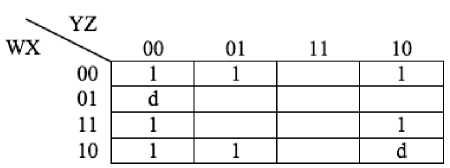
(b)
Figure 4. Sample Quiz Problem.
Fig.4 shows sample of a question related to k-map simplification for an extra credit surprise quiz. In the class or in regular quiz, a problem such as Fig. 4(a) is given. Whereas, problem such as Fig.4(b) is given during the extra credit quiz. As evident from this sample, students not only have to think of different dimensions but also have to use different properties ( don’t care terms for this example) of the algorithm to find solutions for the extra credit quiz questions. Table 2 contrasts sample characteristics to distinguish questions in the quizzes.
We also assigned one of three-difficulty level to each questions (low, medium, high) and used that for later grade calculations, however students were not informed about the difficulty level of the questions given. This kind of strategies in selecting items for the quizzes eliminates lax student attitude towards extra credit and engage them more into learning advanced topics.
table 2. Question characteristics.
|
Question in scheduled quiz |
Question in extra credit quiz |
|
Whole number conversion between bases. |
Conversion of numbers with fractions. |
|
Single or double variable equations. |
More than two variable equations. |
|
K-maps without don’t-care terms |
K-maps with don’t care terms |
|
Circuits with one output. |
Circuits with multiple outputs. |
|
Circuit with primitive gates. |
Circuits with advanced gates. |
|
Timing diagram without delay. |
Timing diagram with delay. |
|
Circuits without enabler. |
Circuits with enabler. |
|
Circuits without memory. |
Circuits with memory. |
-
E. Placement of Extra Credit Quizzes
As a standard, every semester the course had a midterm and a final exam. There were one scheduled quiz between the start of the semester to mid-term and one between mid-term and the final. So, extra credit quizzes were placed between the start of the semester and the first quiz and between the quiz and the mid-term and so on. As shown in Fig. 5, there can be zero to a number of extra credit quizzes placed between two major assessment items (Scheduled Quiz, Mid-term, Final). Each extra credit quiz can vary in difficulty level (as represented by white sub-circle). In turn, the difficulty level is the weight that a particular extra credit quiz will be counted toward the grade calculations. How many extra credit quiz of a certain difficulty level will be given is determined by student participation and performance in the course. Also, there is not a set number of extra credit quizzes between two assessment items, mainly because it also depends on factors such as course content covered, student interest and student participation.
-
F. Grade Calculations
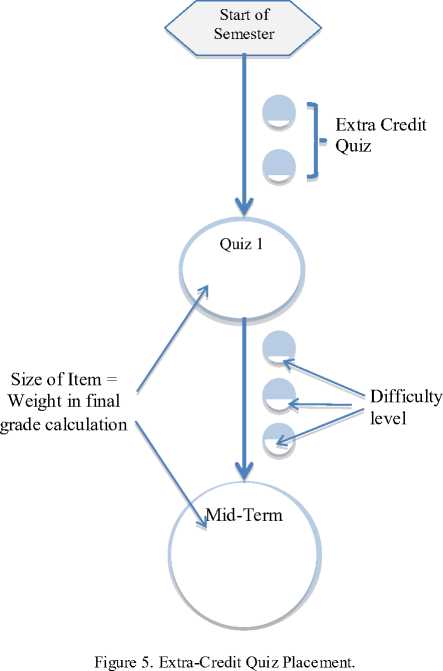
So, for instance in Fig. 5, two extra credit before Quiz 1 will be included in grade calculation of Quiz 1 and the three extra credit quizzes before the mid-term will be incorporated with the mid-term grade. The three difficulty levels were assigned a weight as follows: D 1 (low): 10%,
D 2 (medium): 25%, D 3 (high): 50% (more reward for difficult questions). Then we calculate the grade of a scheduled assessment item as follows:
n
A fina! = A scheduled + Э ( EC ° D ij ) ...........................( 1 )
i = 1
Where, A final = The final score of the assessment item and A final ≥ 0 and A final ≤ A max_point_alloted
A scheduled = Score attained in the scheduled assessment item.
EC = Extra credit quiz score
D ij = Difficulty level of extra credit quiz i
Since the final grade of the course is calculated as a weighted average of all scheduled assessment items, there is minimal chance of using extra credit work in a way that violates ethical standards. Also, the maximum grade of any schedule assessment item would be pre-scheduled points allotted to that assessment item. So, if a student’s grade on a certain assessment item goes over that prescheduled limit after adding the extra credit points, it will be limited within the pre-scheduled points.
-
III. FINDINGS
Spending some extra time and effort to develop the extra credit quizzes produced positive outcomes. First, we looked at how students felt about the extra credit quizzes and whether the course materials have challenged them? Fig. 6 shows the responses given by students at the end of semester course evaluation survey. Most students (around 80%) either agree or strongly agree that the course materials have challenged them and they went beyond simple memorization.
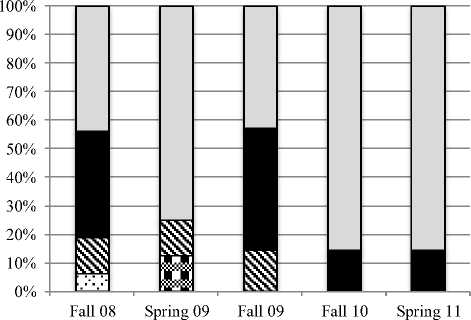
Strongly Disagree Disagree Neutral Agree Strongly Agree
Figure 6. Student’s Feeling about being challenged in the Course.
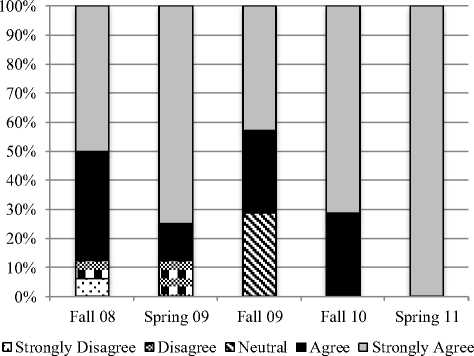
Figure 7. Student’s Feeling about applying learned knowledge.
Next we looked at, whether student felt that they applied the knowledge and skilled learned in the course content to solve problems (Fig. 7). This is to gaze student’s attitude towards their learning experience in the course. Again, more than 80% of the students either agreed or strongly agreed that they have acquired skills that they can use to solve problems.
The analysis of the student scores in both types of quizzes indicates that the use of extra credit in a quiz form has a positive impact on student learning. Fig. 8 shows the average of student scores in both the scheduled and extra-credit quiz. It is clear to see from Fig. 8 that students always performed better in extra-credit quizzes than the scheduled quiz. This result appears to support a correlation between the score earned in a quiz and student’s learning ability. It also showed that, reliving students from exam anxiety, they learn more (evident from solving difficult problems in the extra-credit quizzes) and perform better than usual assessment methods (such as an exam). It also implies that extra credit motivates students and when presented as part of the total course activities and is relevant to the overall course objectives, students will benefit (not only grade wise, but also in the amount of learning) from the effort.
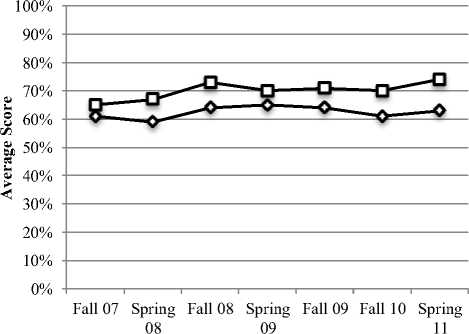
Scheduled Quiz —о— Surprise Quiz
Figure 8. Student Performance in Two Types of Quizzes.
-
IV. CONCLUSIONS
This paper presents a case study of using extra credit to motivate students to perform better in advanced topic and learn more out of a Computer Science course. The methodology and the findings from this study provide directions to the proper use of extra credit to improve student learning. It is to be noted that there is a lack of pedagogical research on the use of extra credit in computer science curriculum and this paper will shed some light into this area.
This case study attempted to address as many factors that were available at the instructor’s disposal to identify potential impact of extra credit on student learning. However, more research is needed to fully understand the impacts of such extra credit quizzes. Future research should attempt diverse strategies to incorporate extra credit in coursework and evaluate and monitor student learning by using academically relevant indicators.
Список литературы Using Extra Credit to Facilitate Extra Learning in Students
- Norcross, J.C., Horrocks, L.J., and J.F. Stevenson, 1989, "Of barfights and gadflies: Attitudes and practices concerning extra credit in college courses," Teaching of Psychology, 16, 199-203.
- Danielson, L, Teaching Strategies and grading, The English Teacher, http://teacher2b.com/strategies /excredit.htm.
- Wilson, M., Evidence that Extra Credit Assignments Induce Moral Hazard, Atlantic Economic Journal, http://findarticles.com/p/articles/mi_hb6413/is_1_30/ai_n28912014.
- Newsweek Magazine, 1996, "Making the Grade", http://www.thedailybeast.com/newsweek/1996/06/16/ making-the-grade.html.
- Hill, G.W., Palladino, J.J., and J.A. Eison, 1993, "Blood, sweat, and trivia: faculty ratings of extra-credit opportunities," Teaching of Psychology, 20 (4), 209-212.
- Weimer, M., 2011, "Revisiting Extra Credit Policies",The Teaching Professor, http://www.facultyfocus.com/articles/teaching-professor-blog/revisiting-extra-credit-policies/.
- Junn, E.N., 1995, "Empowering the marginal student: A skills-based extra-credit assignment," Teaching ofPsychology, 22 (3), 189-192.
- Mays, T. and Bower, K., 2005, "Analyzing the Effects of Extra Credit Opportunities on Student Learning, Motivation and Faculty Perceptions", Proceedings of the ASEE Southeast Section Conference, Chattanooga, TN, April 3-5.
- Miller, D., 2006, "Extra Credit: Does The Systematic Use Have An Effect On Student Learning?",24thEuroCHRIE Congress, Thessaloniki, Greece, 25-28 October.

